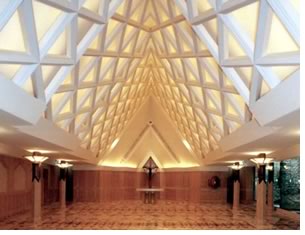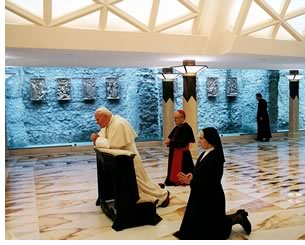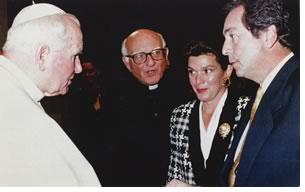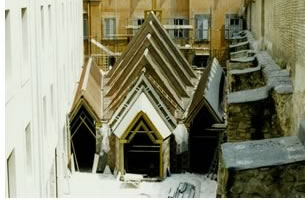

04/2005
Louis D. Astorino, FAIA, is the first American architect to design and complete a building at the Vatican, the Chapel of the Holy Spirit. Completed in 1996, the chapel serves not only as a private chapel for visiting clergy, but also as a place for the College of Cardinals to pray and reflect before they headed to the Sistine Chapel to vote for a new pontiff.
Pope John Paul II—who attended the two conclaves of 1978 after the death of Pope Paul VI, and then of Pope John Paul I only 33 days after he was elected—determined that the extreme discomfort of the cardinals’ quarters during conclaves was unnecessary, especially given that conclaves can last weeks, months, or, rarely, years. The Pope wanted to ensure that the next conclave would prove more hospitable, so he authorized the building of the Domus Sanctae Marthae, a hotel on the grounds of the Vatican, and an adjacent chapel where the cardinals could reflect in private and pray for guidance.
 In 1993, Astorino was asked to consult on the Domus Sanctae Marthae. “Once
they saw how well we worked with [the Vatican architects], Cardinal Castillo
Lara, then the president of the Administration of the Patrimony of the
Holy See, asked us if we’d like to design a chapel,” says
Astorino. In a public television documentary entitled From
Pittsburgh to the Vatican (WQED, 2004) Astorino recalls feeling despondent that
his design for the Domus Sanctae Marthae wasn’t selected for construction,
but that didn’t keep him down for long. Just a few days later,
Cardinal Lara called him back to Rome to ask if he would design the Chapel
of the Holy Spirit on a site between the Domus Sanctae Marthae and the
Leonine Wall, the fortification separating Rome from the Vatican that’s
named for Pope Leo III, who rebuilt the crumbling divide in the 9th century.
In 1993, Astorino was asked to consult on the Domus Sanctae Marthae. “Once
they saw how well we worked with [the Vatican architects], Cardinal Castillo
Lara, then the president of the Administration of the Patrimony of the
Holy See, asked us if we’d like to design a chapel,” says
Astorino. In a public television documentary entitled From
Pittsburgh to the Vatican (WQED, 2004) Astorino recalls feeling despondent that
his design for the Domus Sanctae Marthae wasn’t selected for construction,
but that didn’t keep him down for long. Just a few days later,
Cardinal Lara called him back to Rome to ask if he would design the Chapel
of the Holy Spirit on a site between the Domus Sanctae Marthae and the
Leonine Wall, the fortification separating Rome from the Vatican that’s
named for Pope Leo III, who rebuilt the crumbling divide in the 9th century.
 Replete with the sacred
Replete with the sacred
Although just 3,300 square feet in plan, the Chapel of the Holy Spirit
glows rich in materials and details. Constructed of travertine, marble,
copper, masonry, mahogany, and glass, the chapel is replete with the
sacred. Wedging the chapel onto a triangular site, Astorino incorporated
the symbolism of the Holy Trinity (represented by a triangle) throughout:
the marble floors are cut into “1,200 or 1,300 different sized
triangular pieces”; the nave, east and west walls, and northern
bell tower contain triangular elements; and the altar sits on a large
marble triangle surrounded by 12 triangles that represent Jesus and
his apostles.
A sculpture of an inverted cross honoring St. Peter (the first pope, who was crucified with his head downwards) sits at the chapel’s entrance directly on axis with the dome of St. Peter’s Basilica and his grave. Charged with constructing a chapel that would “reflect today’s thinking and blend with the history and magnificence of the surrounding architecture,” Astorino’s design incorporates the history of the Vatican and imbues the chapel with tranquility by enclosing one side of the Chapel of the Holy Spirit with a glass wall looking onto the Leonine Wall. The result is a space that delights the spirit and infuses the soul with warmth and light.
 Although
humble about his role in the project, Astorino takes pride in the fact
that “there’s a connection between everyday America
and this selection of a pope in the fact that an American architect designed
this chapel that the were inspired in and prayed in before they
went to vote.” Calling the Chapel of the Holy Spirit his “firm’s
greatest work” and his participation in the project a life-enriching
experience, Astorino notes, “I felt I was just a pencil in God’s
hand. I don’t think any of this was my idea. I just happened to
be the vehicle.”
Although
humble about his role in the project, Astorino takes pride in the fact
that “there’s a connection between everyday America
and this selection of a pope in the fact that an American architect designed
this chapel that the were inspired in and prayed in before they
went to vote.” Calling the Chapel of the Holy Spirit his “firm’s
greatest work” and his participation in the project a life-enriching
experience, Astorino notes, “I felt I was just a pencil in God’s
hand. I don’t think any of this was my idea. I just happened to
be the vehicle.”
Copyright 2005 The American Institute of Architects.
All rights reserved. Home Page ![]()
![]()
 |
||
|
||
